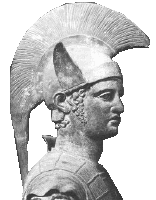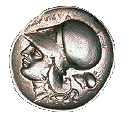
This statue of Ares has always seemed to me to be a perfect depiction of the god of war. Despite his impressive helmet and armor, he's still got kind of a weak chin and a sulky expression.
 This statue of Ares has always seemed to me to be a perfect depiction of the god of war. Despite his impressive helmet and armor, he's still got kind of a weak chin and a sulky expression. |

|
Roman Name: Mars |
Images of Ares, courtesy of Laurel Bowman of the University of Victoria
You won't see very many images of Ares on his own, other than on coins--which were sometimes struck to celebrate military might or a specific victory--and in statues from his temples. Unlike his more flexible Roman counterpart Mars, the Greek war god was identified entirely with the violent aspects of war. Thus, he inspired fear but not a great deal of respect or affection. He's usually depicted with somebody else, perhaps to mitigate his terrifying presence.
Not too surprisingly, that somebody else is usually his lover Aphrodite. Perhaps the two of them, love and war, cancel each other's power out. As I mentioned on our class Aphrodite page, a popular theme in art is the disarming of war by love, where Aphrodite herself or her son Eros is shown playing with Ares' weapons and reducing them to toys. That particular image always seems to me to be an interesting example of wishful thinking. Well, at least it worked for Lysistrata in Aristophanes' play.
War in Ares' territory means confusion and frenzy, the war-cry of the soldiers and the spilling of blood. He's not a god of counsel or of noble acts of self-sacrifice on the battlefield; that's the function of Athene. While she inspires strategy, he inspires blood lust--which is why, in the Saturday Night Live skit on the Greek economy, Zeus discovered that there are two gods of war in the Greek pantheon. This mitigating act of Athene on other gods' areas of expertise isn't too unusual; we also see her improving touch in the story of how Poseidon invented the horse, but Athene invented the bridle that enabled humans to ride on that horse (and, with it, the chariot and harness that made equestrian warfare possible in a world before the invention of the stirrup made it possible to fight from horseback). But this isn't a page about Athene. Back to Ares.
When Ares goes to the battlefield he is accompanied by Strife and Riot, and sometimes Eris, the goddess of strife who kicked off the Trojan War with her golden apple scheme. Sometimes he also brings along the Keres, daughters of Nyx (Nyx = night, also the mother of the Erinyes or Eumenides... the Furies) who were so noxious the Athenians held an annual ceremony to drive them out of their homes during the spring festival of Anthesteria. This festival was particularly sacred to Dionysus, which makes sense when you consider that perhaps more than any of the male gods it's usually Dionysus who is a lover rather than a fighter. When it comes to the Trojan War stories, Dionysus isn't even mentioned as an onlooker, much less a participant or side-taker. But this isn't a page about Dionysus. Back to Ares.
Ares' faithful companions or sons--or sometimes they're said to be his horses--Phobos (fear) and Deimos (terror), have lent their names to the two satellites that circle the planet Mars. The planet has been associated with Mars/Ares since the Roman period, since it appears reddish even to the naked eye. Ares' connection with the color red is self-evident and needs no explanation.
Ironically, the god of war is a coward at heart. When wounded by the Greek hero Diomedes in Book 5 of the Iliad, he actually runs straight home to whine about it to Zeus! But not until after he "bellowed loud as nine thousand warriors or ten thousand cry in battle." Kind of wussy behavior for a god, much less a war god--makes one wonder just what the term "battle cry" means, after all.
Even Ares' own father doesn't like him, if Homer is to be believed. Zeus gets quite disgusted with him when he tries to complain that Diomedes, a mere mortal, has dared to wound him on the field at Troy with the help of Athene (note the flattering description of Ares as "the bane of mortals"). The King of the Gods defends his favorite daughter and treats his least-favorite son to a rousing scold:
That is, of course, assuming that you believe the story that Zeus is actually Ares' father. As you know, other accounts say that Hera gave birth to him alone, out of jealousy that Zeus had given birth unaided to Athene. She did that twice: Hephaestus turned out ugly on the outside but beautiful on the inside, and Ares turned out the other way around, so she never did get it quite right.
Ares had his equivalents in Egypt (according to Herodotus 2.59-63), Scythia (Herodotus 4.59-62, who says "It is [the Scythians'] practice to make images
and altars and shrines for Ares, but for no other god"), and in Thrace (Herodotus 5.7, where he claims that the common people "worship no gods but
Ares, Dionysus, and Artemis"--in short, the gods associated with wild things--though interestingly
enough, "Their princes, however, unlike the rest of their countrymen, worship Hermes above all gods
and swear only by him, claiming him for their ancestor."). Both the
Scythians and the Thracians were frightening, warlike races from the
rugged north, whom the Greeks considered savages. All kinds of bizarre stories were told about
their savage habits, and when talking about Ares' geographical preferences, the Greeks tended to
say that he was especially fond of Thrace or even that he originally came from there.

Some years ago I saw an episode of Xena: Warrior Princess--purely as an intellectual experiment, you understand--and one of the characters, a Roman legionary, described Xena as a "Thracian." I don't know if she's always said to be a Thracian, since I'm not a big Xena fan, but that designation seemed strangely appropriate. Xena's habitual armor and the way she's always ready for a fight certainly do have Thracian overtones, as does her fondness for horses: the Thracians and Scythians were supposed to be great horsemen. Most of the fighting in the Iliad and other classical poems about war takes place from chariots rather than from horseback, and there's a good reason for that. Until the invention of the stirrup in the time of Charlemagne, anyone on horseback was perched too precariously to fight securely with a sword, so if you were brave or foolhardy enough to fight while riding a horse you pretty much had to be consumed by blood lust.
Xena is a creature created by Ares, no doubt about it. A follower of Athene, goddess of strategy in war, would be a lot more like the soft-spoken Colin Powell than like Xena the Warrior Princess.
 |
Just outside the gate to the temple complex that contains the Parthenon, the Areopagus is an enormous, jutting stone cliff that overlooks the city. Saint Paul once preached there. Its surface is worn almost as smooth as glass by untold centuries of climbers, so if you plan to visit it make sure you're wearing shoes that are easily removed. I've climbed it many times myself, but have never had the courage to tackle it except barefoot. And if you're afraid of heights, I wouldn't recommend climbing it at all. The spectacular view adds to the awesome effect the place has--and must have had on those who were tried or passed judgment there--but that awe is mixed in with a dizzy and rather terrifying reaction. Maybe that's why it's associated with the god of something as awe-inspiring, vertigo-inducing, and terrifying as war.
Mars was much more highly respected by Romans than Ares was by Greeks, no doubt because of Rome's imperial aspirations. The Romans held multiple festivals in his honor and even named the month of March (Martius) in his honor. The word "martial," as in "martial arts," comes from his name, too.
As our textbook points out on page 865, the Romans traced their ancestry back to Mars through his children, Romulus and Remus. There's a great picture of these two boys being suckled by a wolf on page 858 and a detailed description of the story of their birth on page 860. Harris and Platzner also suggest that he might have become associated with an old Etruscan "agricultural deity," a chthonic deity of sorts. With this added aspect, the essential sterility that war brings about is mitigated with an overlayer of fertility.
 |
Later, as Roman priorities changed, this original threesome together was replaced by the "Capitoline" triad of Jupiter, Juno and Minerva.
Still later, a cult of Mars Ultor, or Avenger, was established. It had a central statue in the temple of Mars Ultor at the Forum of Augustus and was intended to refer to the divine protection of Augustus Caesar's family, with particular reference to the avenging of Julius Caesar's assassination.
To read more about Ares, click here for his entry from the Encyclopedia Mythica and here for Carlos Parada's overview of myths about Ares in capsule form, and here for ancient texts referring to him.
Return to the top of this page